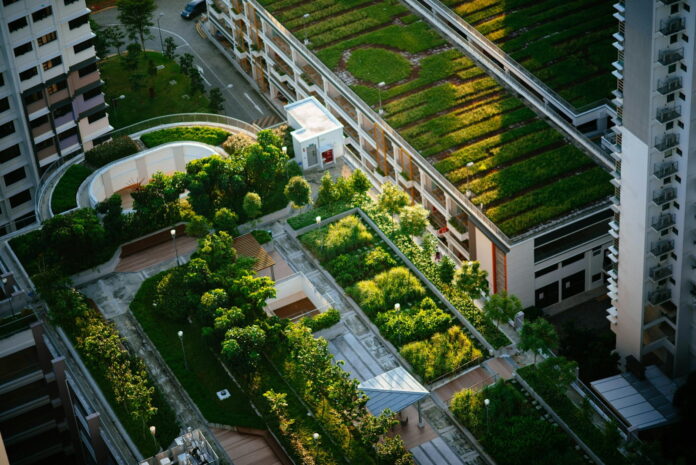In the heart of our concrete jungles, a revolution is taking root. Green roofs and walls, also known as living roofs and vertical gardens, are transforming urban landscapes worldwide. These innovative solutions involve the integration of vegetation into the fabric of buildings, creating a symbiotic relationship between nature and architecture. Green roofs are horizontal surfaces covered with vegetation, while green walls are vertical surfaces adorned with plant life. Both are designed to bring a slice of the natural world into urban environments, offering a plethora of benefits that extend far beyond mere aesthetics.
The concept of green roofs and walls is not new; it has ancient roots and has been part of human architecture for centuries. However, the modern iteration of these living systems is a response to the pressing environmental challenges of our times. By incorporating plants into building designs, architects and city planners are not only enhancing the visual appeal of structures but also contributing to the health and sustainability of urban areas.
Environmental Advantages: How Green Roofs and Walls Combat Urban Heat Islands
One of the most significant environmental benefits of green roofs and walls is their ability to mitigate the urban heat island effect. This phenomenon occurs when cities absorb and retain heat due to the prevalence of dark, impermeable surfaces like asphalt and concrete. Green roofs and walls counter this effect by providing natural insulation and cooling through the process of evapotranspiration, where plants release water vapor into the air.
Studies have shown that green roofs can reduce the surface temperature of a roof by up to 30°C (86°F) and the surrounding air temperature by approximately 5°C (9°F). This not only makes the immediate environment more comfortable but also reduces the demand for air conditioning, leading to lower energy consumption and decreased greenhouse gas emissions. In densely populated cities, widespread adoption of green roofs and walls could significantly reduce the overall urban heat island effect, contributing to a cooler, more sustainable urban climate.
Biodiversity Boost: Encouraging Wildlife with Vertical and Horizontal Green Spaces
Green roofs and walls serve as vital habitats for a variety of species, particularly in urban areas where natural spaces are scarce. By introducing a range of plant life, these living architectures create ecosystems that attract and support insects, birds, and even small mammals. The increased vegetation provides food sources, nesting sites, and safe passageways for wildlife, enhancing urban biodiversity.
The presence of diverse plant species on green roofs and walls can also serve as a stepping stone for pollinators, such as bees and butterflies, allowing them to move across urban areas that would otherwise be inhospitable. This is crucial for maintaining healthy populations of these important creatures, which are essential for pollinating crops and maintaining ecological balance. By fostering biodiversity, green roofs and walls not only enrich the urban environment but also contribute to the resilience and sustainability of urban ecosystems.
Energy Efficiency and Cost Savings: The Insulating Power of Living Architecture
Green roofs and walls offer significant energy-saving benefits. The layer of vegetation and soil provides natural insulation, reducing the need for heating in the winter and cooling in the summer. This thermal regulation can lead to substantial cost savings for building owners. For instance, a green roof can reduce a building’s energy consumption for heating by up to 25% and for cooling by up to 75%.
The initial investment in green roofs and walls can be offset by the long-term energy savings they provide. Additionally, these living systems can extend the lifespan of roofing materials by protecting them from ultraviolet radiation and temperature fluctuations. This means that the roof may need to be replaced less frequently, resulting in further cost savings and reduced waste.
Stormwater Management: Green Roofs and Walls as Natural Sponges in the City
Urban areas often struggle with stormwater management due to the prevalence of impermeable surfaces that prevent water from naturally soaking into the ground. Green roofs and walls can absorb and retain a significant amount of rainfall, acting as natural sponges that reduce the volume of runoff and delay its entry into the sewer system. This can alleviate the pressure on urban drainage systems and decrease the risk of flooding.
The vegetation on green roofs and walls can retain up to 90% of the rainwater that falls on them during the summer and 40% during the winter. This not only helps manage stormwater but also purifies it by filtering out pollutants. The retained water can then be used by the plants or slowly released back into the atmosphere through evapotranspiration, contributing to a more sustainable water cycle within the urban environment.
Enhancing Aesthetics and Well-being: The Psychological Benefits of Integrating Greenery into Buildings
Beyond their environmental and economic advantages, green roofs and walls significantly enhance the aesthetics of buildings and the well-being of their occupants. The presence of greenery has been shown to reduce stress, improve mood, and increase productivity among residents and workers. Access to natural elements can also promote physical activity and social interaction, contributing to a higher quality of life.
Urban dwellers often suffer from a disconnection with nature, a condition known as “nature deficit disorder.” Green roofs and walls can help bridge this gap by bringing natural elements into everyday urban settings. Hospitals with green spaces, for example, have reported faster recovery rates among patients, demonstrating the healing power of nature. Furthermore, green roofs and walls can increase property values and attract businesses and residents looking for a healthier, more visually appealing environment.
Green roofs and walls are not just a trend in modern architecture; they are essential components of a sustainable urban future. By embracing these living solutions, we can combat the urban heat island effect, boost biodiversity, achieve energy efficiency, manage stormwater, and enhance the well-being of city inhabitants. As we continue to face environmental challenges, the integration of greenery into our buildings will play a crucial role in creating resilient, healthy, and beautiful urban landscapes for generations to come.
